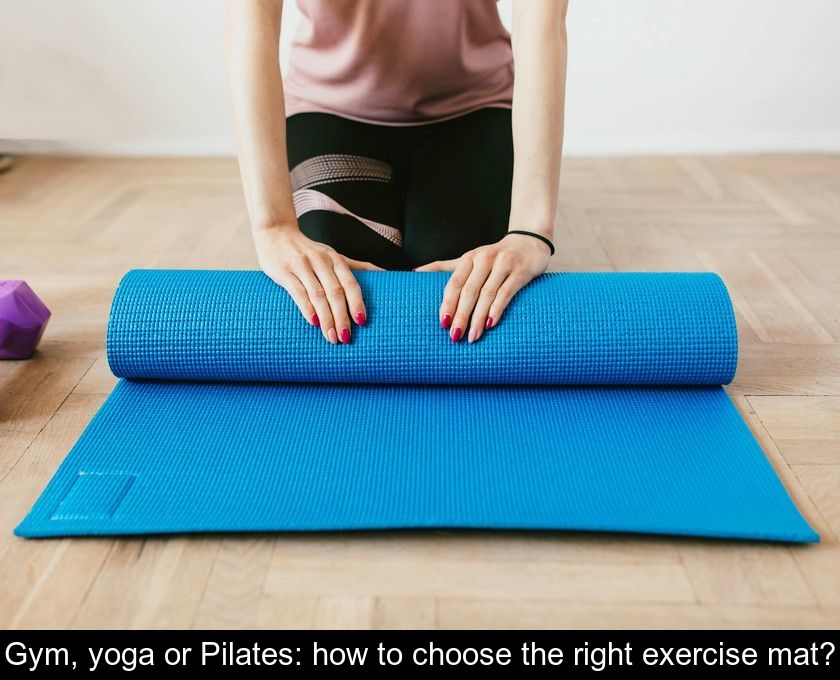Gym, Yoga Or Pilates: How To Choose The Right Exercise Mat?
A must-have accessory when doing fitness exercises, Pilates, or yoga, the mat comes in a multitude of models in sports stores. If you don't know what to choose among this plethora of options, check out our buying guide! We will explain how to choose the right exercise mat.
Choosing the mat based on its use
To choose the right exercise mat, you must first select a model suited to your practice. Pilates mats, for example, are not the same as yoga and gym or fitness mats... Before buying your mat, ask yourself which postures or moves you will be performing and whether you will practice in shoes or barefoot.
Since Pilates exercises are performed sitting, kneeling, or lying on the back, mats designed for this practice are thicker and denser than others.
Yoga mats are characterized by their non-slip properties to help users hold balance postures without slipping. They are also longer than others to allow yogis to perform movement sequences like the famous Sun Salutation!
Note: Generally, yoga mats are quite thin. However, if you usually end each yoga session with a period of meditation or relaxation, it is advisable to choose a slightly thicker mat for added comfort.
Finally, the fitness mat is the most versatile of all. Designed to absorb shocks, it is also very resistant to abrasion, so it can be used while wearing sports shoes. Conversely, Pilates and yoga mats are designed to be used barefoot.
Compare several models
You will understand, a good mat is above all a mat suited to your practice and your habits.
To choose the right floor mat, it is important to compare several models considering the following criteria:
• the thickness of the mat: it can vary from 3 mm to 20 mm and this makes all the difference in terms of comfort and thermal insulation.
• the length of the mat: most models measure between 140 and 160 cm long. However, if you are tall or want to be more comfortable in your movements, you can opt for an XXL model, measuring between 180 and 190 cm.
• the weight of the mat: even though this criterion does not directly affect your sport practice, it is very important if you need to carry this accessory to the yoga studio or the fitness room!
Note: if you use it only at home, you can choose a thick and large mat. On the other hand, if you want to take it everywhere with you, weigh several models before buying and select a mat weighing between 500 g and 1 kg maximum.
Check the material of the carpet
Another important criterion for choosing a good floor mat is the material used on both sides. The base of the mat must adhere to the floor and not slip, especially if you want to perform dynamic yoga or gym sequences.
To prevent slipping, natural rubber is a good choice for outdoor sports enthusiasts as it provides stability on all types of surfaces, including sand or grass… But be careful: natural rubber can cause allergic reactions!
If you are among the many people allergic to latex, opt for a mat made of thermoplastic elastomer or cork. This natural material is both soft to the touch, non-slip, and antibacterial.
If you sweat a lot from your hands and feet, the best material to avoid slipping is microfiber because it gains grip when in contact with moisture.
Good to know
The material used also has a considerable impact on the ecological footprint of this accessory. To avoid polluting components and endocrine disruptors like phthalates, choose hypoallergenic models made from natural materials colored with vegetable dyes. Manufacturers are increasingly using plant-based materials such as organic cotton, cork, or hemp or bamboo fiber, usually combined with a natural rubber base.
Seek the best value for money
The price is, of course, another criterion to consider when choosing your floor mat, especially if you are on a tight budget. Even if you don't want to invest too much in this accessory, I advise you to avoid the cheapest models at around twenty euros. They are generally too rough, not stable enough on the floor, and made from polluting materials.
They also have the disadvantage of not lasting over time. Usually, they crumble and become slippery after several uses. In the end, this choice is not very economical because you will have to buy another one quickly...
If you can, it is better to invest in a good quality mat. This purchase is a long-term investment, particularly for yoga or Pilates enthusiasts who have been practicing these disciplines for several years.







